Charcoal rot, scientifically known as Macrophomina phaseolina, is a plant disease that affects various crops, causing significant damage to agricultural yields. This fungal infection primarily targets the roots of plants, leading to a decline in their overall health and productivity.
The pathogen responsible for charcoal rot thrives in warm and dry conditions, making it a notable concern in regions with hot climates. It has a broad host range, affecting diverse crops such as soybeans, maize, sorghum, sunflowers, and various legumes. The severity of charcoal rot can vary depending on factors like soil moisture, temperature, and the susceptibility of the host plant.
Symptoms of charcoal rot typically manifest in the later stages of plant development. Infected plants often display wilting, a characteristic charcoal-gray discoloration of the stem’s internal tissues, and the presence of small, black structures called microsclerotia. These structures play a crucial role in the fungus’s survival and spread within the soil.
The fungus Macrophomina phaseolina can remain dormant in the soil for extended periods, waiting for favorable conditions to infect susceptible plants. Once a plant is infected, the fungus invades the root system, impairing the plant’s ability to absorb water and nutrients. This results in wilting, stunted growth, and, ultimately, a decline in crop yields.
Management of charcoal rot involves implementing cultural practices and adopting resistant varieties to mitigate the impact of the disease. Crop rotation, maintaining proper soil moisture, and avoiding water stress are essential strategies to reduce the risk of infection. Additionally, researchers continue to explore biological control methods and develop resistant crop varieties to enhance the long-term management of charcoal rot.
However, charcoal rot poses a significant threat to agricultural productivity, impacting a wide range of crops in warm and dry climates. Understanding the disease’s characteristics, symptoms, and management strategies is crucial for farmers and researchers alike as they work towards sustainable and effective solutions to mitigate the impact of this fungal infection on global food production.
Read Also: Japanese Beetles: Description, Damages Caused, Control and Preventive Measures
Plants Affected by Charcoal Rot (Macrophomina phaseolina)

Charcoal rot can affect a variety of crops across different plant families. Some of the major crops susceptible to this fungal disease include:
1. Soybeans (Glycine max): Soybeans are particularly vulnerable to charcoal rot, and the disease can lead to significant yield losses in soybean crops.
2. Maize (Zea mays): Corn, or maize, is another important crop that can be affected by charcoal rot, impacting both the yield and quality of the harvested corn.
3. Sorghum (Sorghum bicolor): Charcoal rot poses a threat to sorghum, a staple cereal crop in many regions, by causing root damage and reducing overall plant health.
4. Sunflowers (Helianthus annuus): Sunflower crops are not immune to charcoal rot, and the disease can affect the plant’s root system, leading to wilting and reduced sunflower yields.
5. Legumes (various species): Charcoal rot can target a range of leguminous crops, such as chickpeas, lentils, and peas, affecting the root structure and overall productivity.
6. Cotton (Gossypium spp.): Cotton plants are also susceptible to charcoal rot, impacting fiber quality and yield in affected crops.
It’s important for farmers and researchers to be aware of the wide host range of Macrophomina phaseolina, as this knowledge is crucial for implementing effective management strategies and developing resistant crop varieties to safeguard against the detrimental effects of charcoal rot on agricultural production.
Damages Caused by Charcoal Rot

Charcoal rot inflicts various damages on affected plants, significantly impacting agricultural productivity. The key damages caused by charcoal rot include:
1. Root Damage: The fungus Macrophomina phaseolina primarily targets the root system of plants. It invades and colonizes the roots, causing structural damage and compromising the plant’s ability to absorb water and nutrients from the soil.
2. Wilting: As charcoal rot disrupts the water uptake mechanism of the plant, one of the most visible symptoms is wilting. Infected plants exhibit wilting even under conditions of adequate soil moisture, leading to a decline in overall plant vigor.
3. Stunted Growth: The compromised root system and impaired nutrient absorption result in stunted growth of affected plants. This has direct implications for crop yields, as smaller and underdeveloped plants are less likely to produce optimal harvests.
4. Reduced Yield: Charcoal rot-induced damages often translate into reduced crop yields. Infected plants may produce fewer fruits, seeds, or grains, depending on the type of crop, leading to economic losses for farmers.
5. Quality Degradation: In addition to quantity, charcoal rot can impact the quality of harvested produce. For crops like soybeans, maize, and sunflowers, the disease may affect the nutritional content and overall market value of the harvested grains or seeds.
6. Residue Formation: The fungus produces black, survival structures called microsclerotia within the infected plant tissues. These microsclerotia can persist in the soil for extended periods, serving as a source of inoculum for future infections and contributing to the long-term sustainability of the disease.
7. Crop Vulnerability: Charcoal rot can render crops more susceptible to other stresses, such as drought or secondary infections. This vulnerability further exacerbates the challenges faced by farmers in maintaining healthy and resilient crop systems.
Understanding the diverse array of damages caused by charcoal rot is crucial for developing effective management strategies. Farmers and researchers alike strive to implement practices that mitigate these impacts, enhance crop resilience, and contribute to sustainable agricultural practices.
Read Also: The Appearance and Features of the Wolf Spiders
Control and Preventive Measures

Controlling and preventing charcoal rot involves a combination of cultural, chemical, and biological strategies. Here are some key measures to manage and mitigate the impact of this fungal disease:
1. Crop Rotation: Implementing a crop rotation system helps break the disease cycle. Avoid planting susceptible crops in the same field consecutively, as this reduces the availability of host plants for the fungus.
2. Resistant Varieties: Planting crop varieties that exhibit resistance to charcoal rot can be an effective preventive measure. Breeding programs focus on developing cultivars with increased resistance to the disease, providing farmers with a valuable tool for managing infections.
3. Soil Moisture Management: Maintaining optimal soil moisture levels is crucial. Charcoal rot thrives in dry conditions, so practices like irrigation and moisture conservation help reduce the likelihood of infection. However, it’s important to balance this with proper drainage to avoid waterlogging, which can also contribute to disease development.
4. Avoiding Water Stress: Preventing water stress in crops is essential, as stressed plants are more susceptible to infections. Adequate watering practices and irrigation scheduling can help minimize water stress and enhance the plant’s ability to withstand charcoal rot.
5. Fungicide Application: In some cases, fungicides may be used to control charcoal rot. However, their effectiveness can be variable, and their use should be part of an integrated disease management approach. Regular monitoring and accurate diagnosis are crucial before deciding on fungicide applications.
6. Biological Control: Researchers are exploring biological control methods to manage charcoal rot. This involves using beneficial microorganisms or natural antagonists that can suppress the growth and activity of the pathogenic fungus.
7. Cover Crops and Organic Amendments: Introducing cover crops and organic amendments can enhance soil health and promote the growth of beneficial microorganisms. This, in turn, contributes to a more balanced soil ecosystem and may help suppress the development of charcoal rot.
8. Sanitation Practices: Removing and destroying infected plant residues after harvest can reduce the presence of inoculum in the field. This practice helps limit the buildup of the fungus in the soil, decreasing the risk of subsequent infections.
9. Monitoring and Early Detection: Regular field monitoring for symptoms of charcoal rot is crucial. Early detection allows for prompt action, helping to minimize the spread of the disease and its impact on crop yields.
By combining these various control and preventive measures, farmers can develop integrated strategies tailored to their specific crops and local conditions, contributing to a more resilient and sustainable agricultural system.
Frequently Asked Questions (FAQs) About Charcoal Rot (Macrophomina phaseolina)
1. Q: What is charcoal rot?
A: Charcoal rot is a fungal disease caused by Macrophomina phaseolina, affecting the roots of various crops. It can lead to wilting, stunted growth, and a decline in crop yields.
2. Q: Which crops are most susceptible to charcoal rot?
A: Charcoal rot can affect a wide range of crops, including soybeans, maize, sorghum, sunflowers, legumes, and cotton.
3. Q: How does charcoal rot spread?
A: The fungus spreads through infected plant residues and produces survival structures called microsclerotia, which can persist in the soil, serving as a source of inoculum for future infections.
4. Q: What are the symptoms of charcoal rot in plants?
A: Symptoms include wilting, a charcoal-gray discoloration of the stem’s internal tissues, and the presence of small black structures called microsclerotia.
5. Q: Can charcoal rot be controlled by fungicides?
A: Fungicides may be used, but their effectiveness can vary. They should be part of an integrated disease management approach, and proper diagnosis is essential before application.
6. Q: How can farmers prevent charcoal rot in their crops?
A: Prevention measures include crop rotation, planting resistant varieties, managing soil moisture, avoiding water stress, using biological control methods, and practicing sanitation by removing infected plant residues.
7. Q: Is there ongoing research to find better ways to manage charcoal rot?
A: Yes, ongoing research focuses on developing resistant crop varieties, exploring biological control methods, and understanding the genetic basis of resistance to improve long-term management strategies.
8. Q: Can charcoal rot affect multiple crops in the same field?
A: Yes, the fungus has a broad host range, and multiple crops in the same field can be affected. Crop rotation is a key strategy to reduce the risk of infection.
9. Q: How long can the fungus persist in the soil?
A: The fungus can remain dormant in the soil for extended periods, thanks to the formation of survival structures called microsclerotia.
10. Q: What should farmers do if they suspect charcoal rot in their crops?
A: Farmers should monitor for symptoms, seek proper diagnosis, and implement integrated management practices, including crop rotation, soil moisture management, and using resistant varieties where available.
Read Also: 10 Reasons Why Food Workers Should Keep Garbage Cans Clean and Free of Buildup

